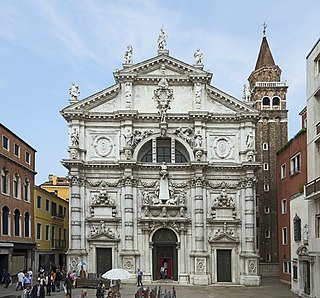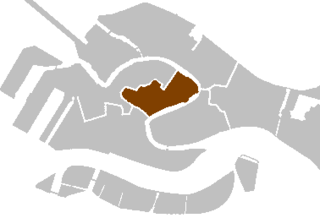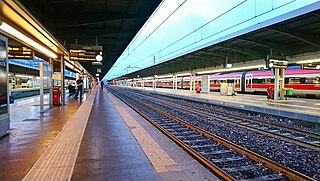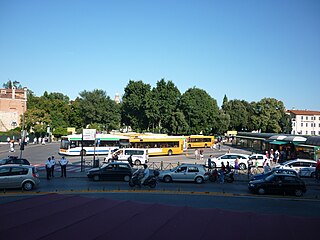

Santa Lucia was a church in Venice, northern Italy, which was demolished in 1861.


Santa Lucia was a church in Venice, northern Italy, which was demolished in 1861.
According to Jacopo Sansovino, the church was founded in 1192 as a local parish dedicated to the Annunciation of Mary. According to the tradition, it changed name in 1279 after the drowning of some pilgrims going to venerate the body of St. Lucy, stolen by the Venetians in the Sack of Constantinople during the Fourth Crusade and then in the island of San Giorgio Maggiore. It was thus decided to move the corpse to the church in the main island of Venice.
In 1580, just before his death, Andrea Palladio had executed some drawings for a renovation of the interior, although the church was finished 30 years after and thus his intervention is disputed [1]
In 1806, after the Napoleonic invasion of northern Italy, the nuns then holding the church and its convent were expelled. In 1860, when the city was connected to the mainland's railway, the complex was destined to demolition. It was replaced by the Venezia Santa Lucia railway station. The saint's body was transferred to the nearby church of San Geremia.

Venice is a city in northeastern Italy and the capital of the Veneto region. It is built on a group of 126 islands that are separated by expanses of open water and by canals; portions of the city are linked by 472 bridges. The islands are in the shallow Venetian Lagoon, an enclosed bay lying between the mouths of the Po and the Piave rivers. In 2020, around 258,685 people resided in greater Venice or the Comune di Venezia, of whom around 51,000 live in the historical island city of Venice and the rest on the mainland (terraferma). Together with the cities of Padua and Treviso, Venice is included in the Padua-Treviso-Venice Metropolitan Area (PATREVE), which is considered a statistical metropolitan area, with a total population of 2.6 million.

The Patriarchal Cathedral Basilica of Saint Mark, commonly known as St Mark's Basilica, is the cathedral church of the Patriarchate of Venice; it became the episcopal seat of the Patriarch of Venice in 1807, replacing the earlier cathedral of San Pietro di Castello. It is dedicated to and holds the relics of Saint Mark the Evangelist, the patron saint of the city.

The Lido, or Venice Lido, is an 11-kilometre-long (7-mile) barrier island in the Venetian Lagoon, Northern Italy; it is home to about 20,400 residents. The Venice Film Festival takes place at the Lido in late August/early September.

Lucia of Syracuse, also called Saint Lucia and better known as Saint Lucy, was a Roman Christian martyr who died during the Diocletianic Persecution. She is venerated as a saint in Catholic, Anglican, Lutheran, and Eastern Orthodox Christianity. She is one of eight women explicitly commemorated by Catholics in the Canon of the Mass. Her traditional feast day, known in Europe as Saint Lucy's Day, is observed by Western Christians on 13 December. Lucia of Syracuse was honored in the Middle Ages and remained a well-known saint in early modern England. She is one of the best known virgin martyrs, along with Agatha of Sicily, Agnes of Rome, Cecilia of Rome, and Catherine of Alexandria.

Cannaregio is the northernmost of the six historic sestieri of Venice. It is the second largest sestiere by land area and the largest by population, with 13,169 people as of 2007.

The Grand Canal is the largest channel in Venice, Italy, forming one of the major water-traffic corridors in the city.

The Chiesa di San Moisè is a Baroque style, Roman Catholic church in Venice, northern Italy.

San Polo is the smallest and most central of the six sestieri of Venice, northern Italy, covering 86 acres (35 hectares) along the Grand Canal. It is one of the oldest parts of the city, having been settled before the ninth century, when it and San Marco formed part of the Realtine Islands. The sestiere is named for the Church of San Polo.

Mazzorbo is one of various islands in the northern part of the Lagoon of Venice. Like the other islands in this part of the lagoon, it was the site of one of the earliest settlements in the lagoon which predated the development of Venice. However, these islands then declined and were eventually abandoned. In the 1980s the architect Giancarlo De Carlo built a brightly coloured residential neighbourhood to help to repopulate Mazzorbo. In 2019 its population was 256. It is linked to Burano by a wooden bridge. It was once an important trading centre but is now known for its vineyards and orchards. Its main attraction is the fourteenth century church of Santa Caterina.

The San Giorgio Monastery is a Benedictine monastery in Venice, Italy, located on the island of San Giorgio Maggiore. It stands next to the Church of San Giorgio Maggiore, which serves the monastic community. Most of the old monastic buildings currently serve as headquarters of the Cini Foundation.

San Giorgio Maggiore is a 16th-century Benedictine church on the island of the same name in Venice, northern Italy, designed by Andrea Palladio, and built between 1566 and 1610. The church is a basilica in the classical Renaissance style and its brilliant white marble gleams above the blue water of the lagoon opposite the Piazzetta di San Marco and forms the focal point of the view from every part of the Riva degli Schiavoni.

Mestre is a borough of the comune of Venice on the mainland opposite the historical island city in the region of Veneto, Italy.

Venezia Santa Lucia is the central station of Venice in the north-east of Italy. It is a terminus and located at the northern edge of Venice's historic city . The station is one of Venice's two most important railway stations; the other one is Venezia Mestre, a mainline junction station on Venice's mainland district of Mestre. Both Santa-Lucia and Mestre stations are managed by Grandi Stazioni and they are connected to each other by Ponte della Libertà.

Malamocco was the first, and for a long time, the only, settlement on the Lido of Venice barrier island of the Lagoon of Venice. It is located just south of the island's center and it is part of the Lido-Pellestrina borough of the municipality of Venice.

Venezia Mestre railway station is a junction station in the comune of Venice, Italy. It is located within the mainland frazione of Mestre, and is classified by its owner, Rete Ferroviaria Italiana, as a gold category station.

Ca' Tron is a palace in Venice, northern Italy, facing the Canal Grande. Part of the sestiere (quarter) of Santa Croce, it is situated between the Palazzo Belloni Battagia and Palazzo Duodo, near the church of San Stae. It is owned by the Università Iuav di Venezia and houses the Department of Design and Planning in Complex Environments.

Piazzale Roma is a square in Venice, Italy, at the entrance of the city, at the end of the Ponte della Libertà. Piazzale Roma and nearby Tronchetto island are the only places in Venice's insular urban core accessible to ground motor vehicles, such as automobiles and buses.
The following is a timeline of the history of the city of Venice, Veneto, Italy.
Ammiana was a settlement in an archipelago in the northern part of the Lagoon of Venice which has disappeared. Its islands were part of a larger number of islands in this part of the lagoon which also included the island group of the next-door settlement of Costanziaco and the islands of Torcello, Burano and Mazzorbo to the south-east. The islands of Ammiana were between the right and left banks of the lagunar channels which today are called della Dolce and San Felice. Another island, which was called tumba della Leseda and is now called La Salina, which lies on the right (eastern) bank of the San Felice channel, was also part of this settlement.
Santa Lucia may refer to: